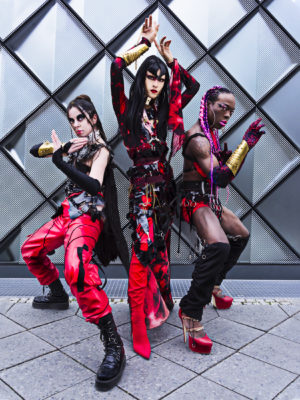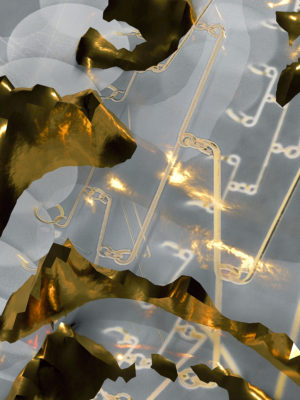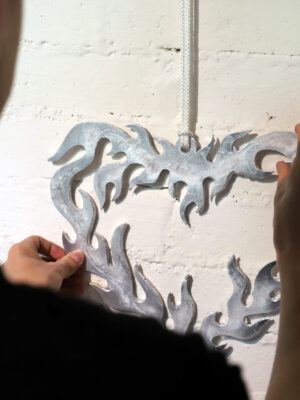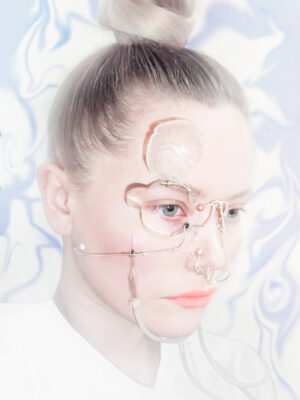Kellie Riggs
What is your entry point to the queer, BDSM, techno communities you feature in your photography?
John Rohrer
It comes back to certain urges, desires, and acts of indulgence within us that society and mainstream culture have largely frowned upon. The United States was founded by Puritans – starting with the conservative colonialist separatists who came here. I believe that conservatism still functions today as a way of shaming people out of their own desires and self interests. Through manipulation and control they try to keep people from being who they really are. The LGBTQ community is a community of oppressed people pushing
against the status quo and heteronormative ideas about identity. That’s why using the right pronouns is so important – it’s not about who people are having sex with or who they are attracted to, it’s about being welcomed and accepted for who and what you are, whether you are a queerdo, lesbian, gender fluid, etc. In an ideal world none of these words should matter. But in order to make ourselves known, we have to use words and create a history through the terminology we express.
I feel the need to talk about these things as a preface to talking about the expressive identities and adornment of BDSM culture, because adornment can frame us in a similar way to language. The accessories people wear can be symbols of the construction of their identities, no matter how deep into the culture they are. What you wear has symbolism and meaning, a language that signifies who you are to other people.
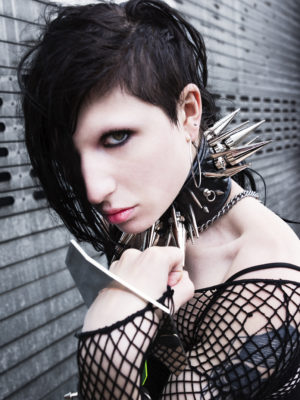
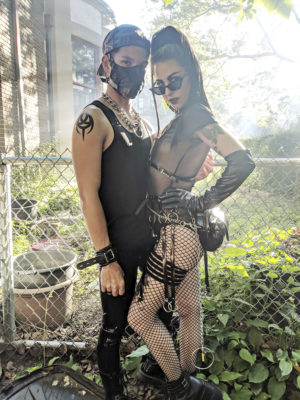
Can you give me some examples?
Wearing chokers, collars, or harnesses might tell someone that you are really into BDSM culture as a practice – they are all used to symbolize acts of subservience or domination. Some might actually be practicing dominatrixes or submissives, others might wear these things superficially. I think the current popularity of this attire is a positive, and active appropriation, which allows others to become more accepting of the culture, and it doesn’t need to stay as hidden as it used to. Fetishwear permeating through pop culture is somewhat an act of resistance. Visibility gives way to the acceptance of BDSM. While acts of BDSM may still happen behind closed doors, people are much more open in ways they were not before. I have friends who are dominatrixes and submissives and who wear different types of fetishwear to both symbolize their positions of power, while demonstrating their types of kink. It’s an act of revealing and concealing.
Chokers and harnesses were originally meant to symbolize submissive behavior. A submissive would wear the choker to let others know they wanted to be controlled or that they wanted to serve their master. In some kinks, a submissive would roleplay as a dog and their dominatrix or master would act as their owner. One end of a chain would clasp into the hoop in their choker or harness and the other end would be held in the hands of their master. The submissive would walk on their hands and knees and be led by their dominatrix.
“I feel the need to talk about these things as a preface to talking about the expressive identities and adornment of BDSM culture, because adornment can frame us in a similar way to language.”
Where does this all happen?
Though much of BDSM takes place privately in dungeons and in homes, the more public subculture that surrounds it intertwines with music. There are underground techno parties, raves, many of which happen behind closed doors and are communicated only by word of mouth. Recently it’s become more mainstream, but fetish parties enforce a dress code so that it’s mandatory to wear fetishwear or put on a look, to engage in some level of participation and contribute to the vibe of the party.
These parties, which are mostly electronic music parties, don’t necessarily have play pens per se, or necessarily require actual acts of domination, but they certainly can. We have parties like this because there are so many other parties and events that are for everyone else. Techno has always been a method, a way for likeminded people to meet each other or hook up, particularly in the queer community. Techno began in Detroit and was birthed out of funk and house music. Long story short: between Detroit, Berlin and New York, the history of techno has been one of creating a community and culture where people could openly express themselves, without inhibition and without prejudice. Whether through dancing, socializing, or roleplaying, parties create a new collective reality.
What is socially acceptable in this arena is very different from what is acceptable within mainstream culture. It’s about creating a moment of clarity away from people telling you what you can and cannot do in order to suspend disbelief and have the unknown take place without restrictions. The intertwining of music, the space, lighting, the crowd, and the clothing worn by the crowd sets the tone for you to indulge in your deepest desires and dive into the unknown.
Can you recall an experience at a party that was particularly meaningful to you?
The first time I went to the techno club Berghain in Berlin I saw people wearing different looks and accessories – everything had a function because of the strict door policy at the time. Apparel had at least the basic function of getting you in the club. But most also used this opportunity to show off their personality and kink. Dancers would wear everything – chokers, spikes, harnesses, dresses, skirts – and sometimes nothing at all. Seeing all these identities defined and re-conceptualized through accessories, adornment, makeup, and apparel etched into my brain a spectrum of beauty within the subculture. Each dancer/party goer created their own mythological archetype that helped to construct the party. It was like seeing a symphony orchestra of freaks and ravers. I fell in love with it immediately.
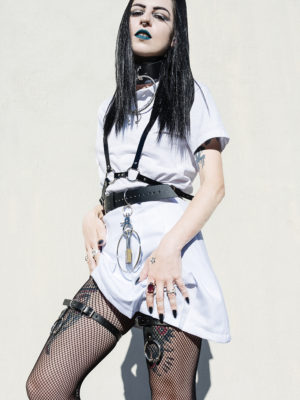
How does music tie directly to subculture?
Different genres of electronic music have ties to different types of identities and cultures. Industrial and EBM (electronic body music) are tied to the goth and youth cultures of the 80s, while house, disco, and techno are tied to LGBTQ communities. Music and adornment are by no means apolitical; every accessory and every track has a political and cultural history associated with it. While accessories and some versions of the music and the culture have become more mainstream, there is a history attached to the clothes that you’re infusing yourself with. You can’t just wear it and say, “Hey, it looks cool.” Everyone wants to look cute and sexy, but you have to ask yourself what you are perpetuating, what lifestyle you are reinforcing, who you are supporting and aligning yourself with. Nothing is neutral, even when there is a level of appropriation by the mainstream. Seeing the various subcultural archetypes represented at a party reminds me of the power and historical value of aesthetics.
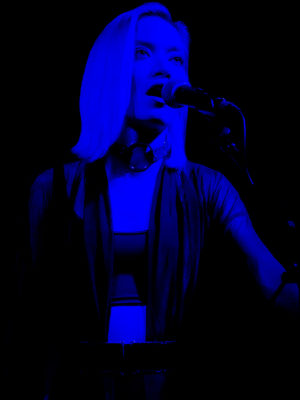
How did you come to do the portraits of this subculture?
Most of the portraits I take are of good friends of mine. We go to parties and raves, share dance floors, mostly in Bushwick or Ridgewood at events like Bound (which is a fetish-themed techno party held at various clubs) or Unter (a rave that’s always held at a different warehouse space in Brooklyn. After the dancing is over, there’s always a moment where people still want to hang out, we’re still wired from the previous night. We would go to a friend’s house to play music and continue the party to the next day. This is called the afters or the post-rave. The party or the rave is really where the boundaries of people’s self-consciousness and self-awareness break down, people really let go of all the shit they are dealing with: work, family, or whatever pulls them down. So the post-rave is really that point where everyone is at their most loose and relaxed. Inhibitions are low, and people are doing ridiculous things, acting out to have fun. That’s where I started taking pictures of my friends, who are all dressed super fabulously; I have a stylist friend who would dress us all. I do not take pictures at the party. It’s typically off limits and makes people feel self-conscious anyway. A lot of clubs have a zero-picture policy for this reason. The more I went to parties here in New York I started to see that my friends had different levels of commitment to queer culture or BDSM and that I could see it through the things they wear.
What’s a good example?
When my friend Commander Ares was living in New York, we would go to parties often and he’d always wear a choker and PVC clothing to show a side of himself he felt he couldn’t reveal during the normal day to day. He talked about having two lives – working at a conservative,
high-end jewelry company by day, and by night acting as a dominatrix with his clients, or subs, specializing in breath play (putting on devices that restrict air flow for autoerotic affixation). The more he was able to go to the techno parties and participate in this community, the more he could reconcile his two personas.
So, I was taking pictures of friends like him at these afters, and I started to ask myself about my own level of involvement in my community, as a dancer, a music enthusiast (noise, electronic, techno), a goth, photographer – all my varying labels. I knew I was a strong proponent of counterculture and finding new ways of being. I then began to think about setting up shoots with my friends. My friend Gia (who is a transgender industrial, hardcore, and techno DJ) and I decided to stage a photoshoot, and that’s when I started to conceptualize the functionality of the post-rave and to make regular portraits of my friends in the community.
How does the overall content of the photo – the look, the accessories, etc. – generally get decided?
All of my photos are collaborations between the subject and myself. Typically, we choose accessories and a concept for the shoot together. Sometimes it is as simple as my friend wanting a portrait; other times it is as complex as creating an overarching theme and picking exact pieces to show a specific intention. All my works are meant to show and highlight subcultures and youth cultures both in electronic music and also in queer culture. For me, taking these photos is a gesture aimed at iconizing my friends while revealing to the world that
what they are doing is acceptable. Most people are very repressed and have so many reservations about who they are and what they do.
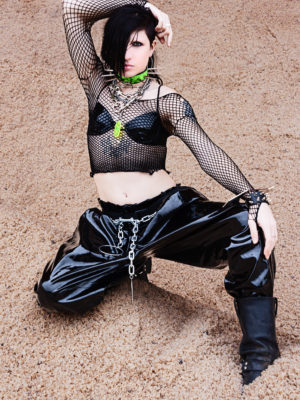
Can you take us through some of your photos and explain what we are seeing?
This photo series was a collaboration between myself and my friends Charlotte, Chaz, and Kyle. I wanted to portray futurism in the Aquarian age. The intent was to convey gender fluidity, fierceness, and flexibility within a futurist dystopic context. I imagine the future to be a place where fluidity extends throughout all aspects of life. In this series, we styled the shoot with accessories and clothing from Chaz, Bitchfist, Jon Marmol, Therapy, and Namillia. Gender fluidity and power is represented in these outfits through the celebration of motifs of alternative lifestyles within sexuality and through the reclamation of power. The chokers and harnesses are again meant to refer to BDSM culture. But when paired with gauntlets and power postures, it is their ferocity and the way they express a confidence in one’s identity that is highlighted instead of any sense of total submission. Here the accessories blur the traditional associations of strength and domination within the gender binary and within BDSM culture. Each of the models reclaims masculine and feminine motifs as a means of constructing powerful, fluid new identities.
What about the photos with Commander Ares?
Ares is a pro-dominatrix. In one photo, he is repurposing tropes of identity within the BDSM community to serve his empowerment. First, by not concealing his identity (most pro-doms wear masks or full rubber as a means of protecting their identity) he is demonstrating his confidence in his identity as a pro-dominatrix. He is showing his true self without any fear or doubt. A choker or collar traditionally represents a submissive identity within BDSM culture. Commander Ares reclaims the choker as a fierce symbol of power. The double rows of sharp spikes demonstrate fierceness and control. These attributes highlight his power and his domination.
In the other photo, Ares, the master, wears a latex cat suit and Bitchfist choker (to show power and dominance) while holding the head of the sub, who wears a latex dog suit and Sinvention leather head harness. They are deemed what we call the latex pup. Ares in his practice believes that all actions during play must be of mutual consent between themselves and their sub. No action will take place without the sub’s consent. Consent equals trust, which in turn equals respect, which allows for more fun. Restriction and role play are methods of gaining a better understanding of one’s desires. The head harness shows a method of control through restriction. They engage with their desire for domination.
Ares’ latex cat suit in this case has a unique significance. Full body latex suits are usually worn by the submissive. But here Ares is wearing it both to show power and to reveal the kinks he participates in.
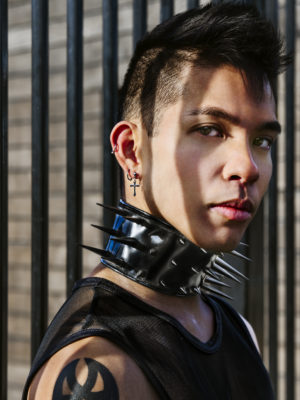
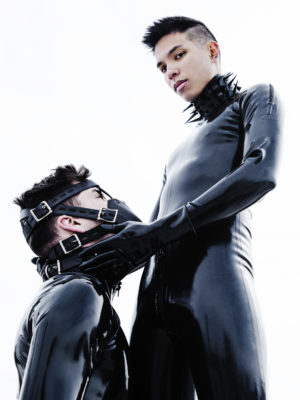
What do you think the photographs mean to the people you are photographing?
When my subject looks at my photographs, I hope they see themselves the way I see them. I see my subjects as the beautiful, talented, and provocative human beings that they are. A lot of my subjects have a dual identity – the photos allow them to establish both their public and private personas in one place, to reaffirm their identity and confidence. The intent behind my photographs is to perpetuate my subjects’ innermost selves; to allow my friends to convey and reconcile their hidden but most actualized self with what they reveal to world. My role as a photographer and artist is to allow people to say that they can be who they are and that’s ok! They shouldn’t have to live in shame. They can be themselves wherever they are. I want everyone to feel free, be free, and live the way they want. My portraits are an attempt to reaffirm and mythologize my friends’ identity while, emanating the subculture they engage in. I hope that one day we can truly be free to express ourselves and be ourselves without oppression or restraint.
This article is published in the 2019 New York City Jewelry Week Paper, the result of a collaboration between Current Obsession and NYCJW.
